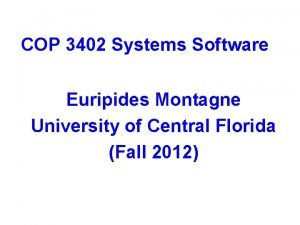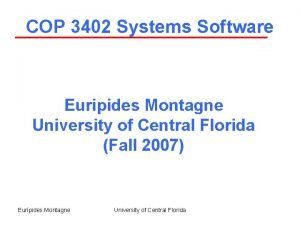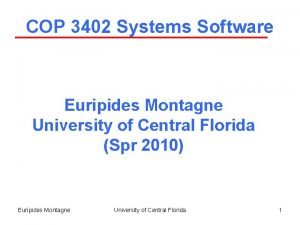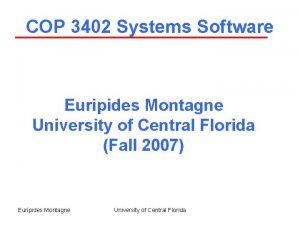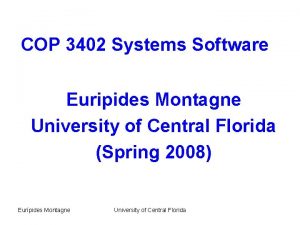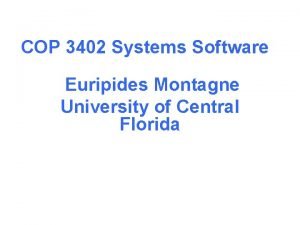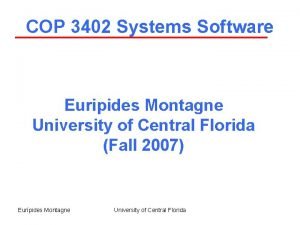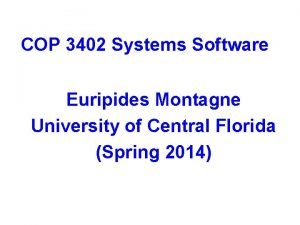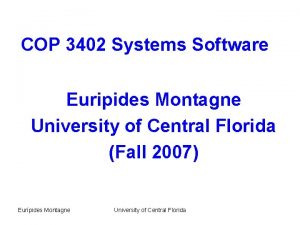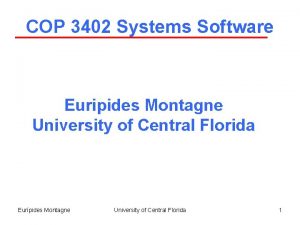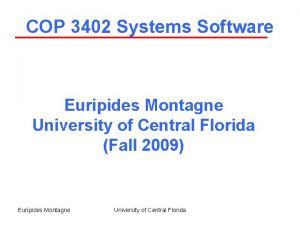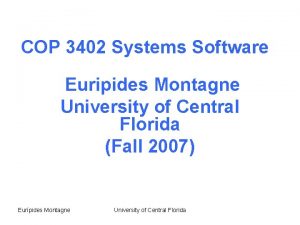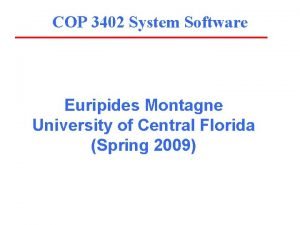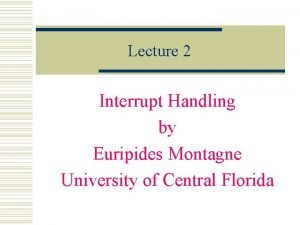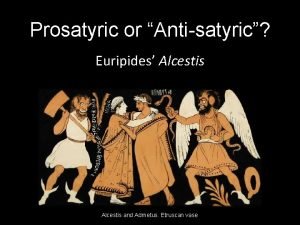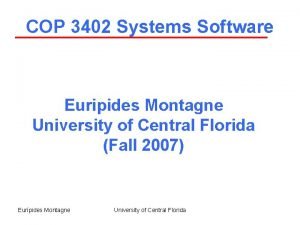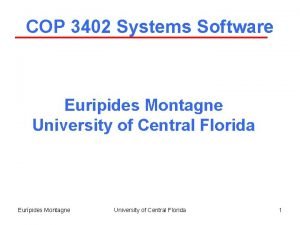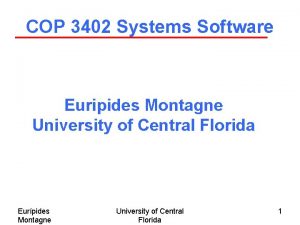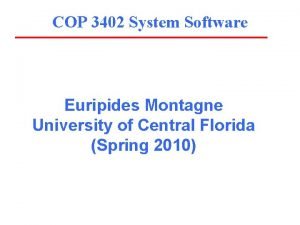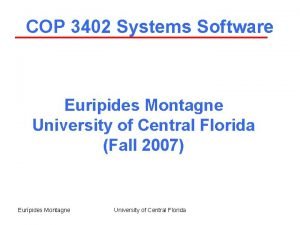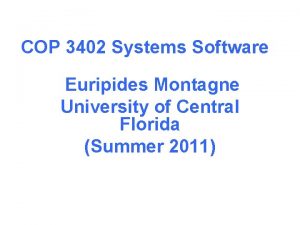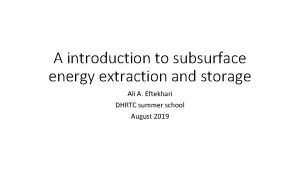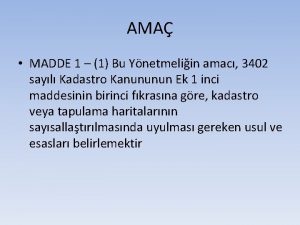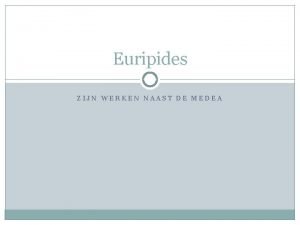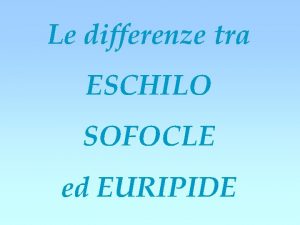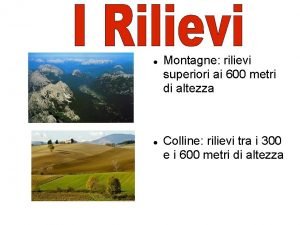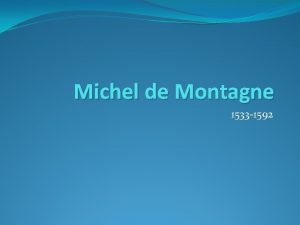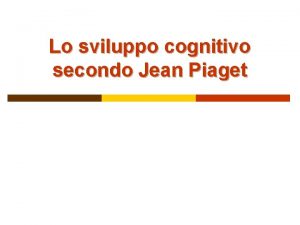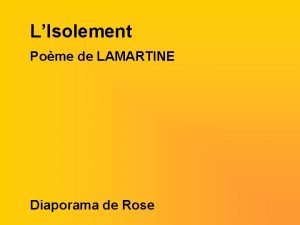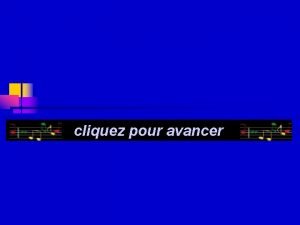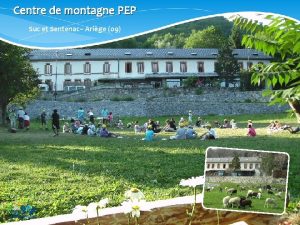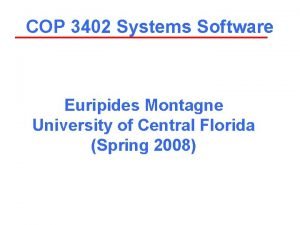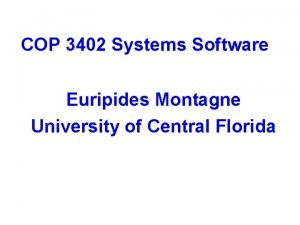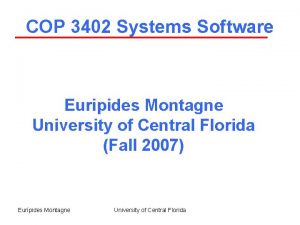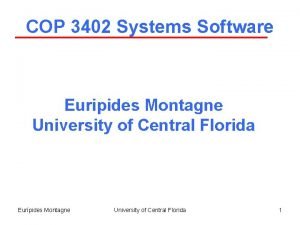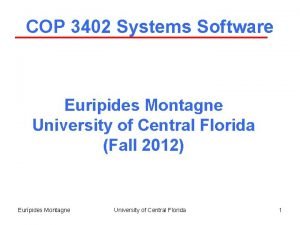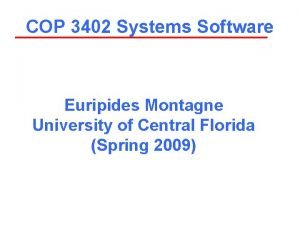COP 3402 Systems Software Euripides Montagne University of




































- Slides: 36

COP 3402 Systems Software Euripides Montagne University of Central Florida (Fall 2009) Eurípides Montagne University of Central Florida

COP 3402 Systems Software Compilers And Interpreters Eurípides Montagne University of Central Florida

Outline 1. Compiler and interpreters 2. Compilation process 3. Interpreters 4. PL/0 Symbols (tokens) Eurípides Montagne University of Central Florida

Compilers / Interpreters • Programming languages are notations for describing computations to people and to machines. • Programming languages can be implemented by any of three general methods: 1. Compilation 2. Interpretation 3. Hybrid Implementation Eurípides Montagne University of Central Florida

Compilers A compiler is a program that takes high level languages (i. e. Pascal, C, ML)as input , and translates it to a low-level representation which the computer can understand execute. Source Program (i. e. C++) Compiler ELF (binary) ELF: Executable Linkable File Eurípides Montagne University of Central Florida

Compilers The process of compilation and program execution take place in several phases: Front end: Scanner Parser Semantic Analyzer Back end: Code generator Source Code Eurípides Montagne Intermediate Front End Code Target Back End University of Central Florida Code

Compilers Optimization Source program Lexical analizer (optional) Intermediate code generator (semantic analyzer) Syntax analizer Lexical units (Tokens) Parse trees Code generator Intermediate code Symbol table Eurípides Montagne University of Central Florida Machine language Computer

EXAMPLE: Fahrenheit : = 32 + celsious * 1. 8 |f|a|h|r|e|n|h|e|i|t|: |=|3|2|+|c|e|l|s| I|o|u|s|*|1|. |8|; | Lexical analyzer (scanner) Getchar() (converts from character stream into a stream of tokens. ) Symbol Table 1 fahrenheit real 2 celsious real [ id, 1 ] [ : = ][ int, 32 ][ + ][id, 2 ][ * ][int, 1. 8 ][; ] index in symbol table Syntax analyzer (parser) (Construct syntactic structure of the program) : = name attribute id 1 + int 32 * id 2 Eurípides Montagne University of Central Florida real 1. 8

: = id 1 + int 32 * id 2 real 1. 8 Symbol Table 1 fahrenheit real 2 celsious Determines de type of the identifier Context analyzer real : = id 1 +r inttoreal int 32 Eurípides Montagne *r id 2 real 1. 8 University of Central Florida

: = id 1 +r inttoreal int 32 *r id 2 real 1. 8 Symbol Table 1 fahrenheit real 2 celsious Intermediate code generator real Temp 1 : = inttoreal(32) Temp 2 : = id 2 Temp 2 : = Temp 2 * 1. 8 Temp 1 : = Temp 1 + Temp 2 id 1 : = Temp 1 Eurípides Montagne University of Central Florida Intermediate code

Temp 1 : = inttoreal(32) Temp 2 : = id 2 Temp 2 : = Temp 2 * 1. 8 Temp 1 : = Temp 1 + Temp 2 id 1 : = Temp 1 Symbol Table 1 Intermediate code Code optimizer fahrenheit real 2 celsious real Temp 1 : = id 2 Temp 1 : = Temp 1 * 1. 8 Temp 1 : = Temp 1 + 32. 0 id 1 : = Temp 1 Eurípides Montagne University of Central Florida optimized code

Temp 1 : = id 2 Temp 1 : = Temp 1 * 1. 8 Temp 1 : = Temp 1 + 32. 0 id 1 : = Temp 1 Symbol Table 1 optimized code Code generator fahrenheit real 2 celsious real movf mulf addf movf Eurípides Montagne id 2, r 1 #1. 8, r 1 #32. 0, r 1, id 1 University of Central Florida assembly instructions

Compilers Lexical analizer: Gathers the characters of the source program into lexical units. Lexical units of a program are: identifiers special words (reserved words) operators special symbols Comments are ignored! Syntax analizer: Takes lexical units from the lexical analyzer and use them to construct a hierarchical structure called parse tree Parse trees represent the syntactic structure of the program. Eurípides Montagne University of Central Florida

Compilers Intermediate code: Produces a program in a different lenguage representation: Assembly language Similar to assembly language Something higher than assembly language Note: semantic analysis is an integral part of the intermediate code generator Optimization: Makes programs smaller or faster or both. Most optimization is done in the intermediate code. (i. e. tree reduction, vectorization) Eurípides Montagne University of Central Florida

Compilers Code generator: Translate the optimized intermediate code into machine language. The symbol table: Serve as a database for the compilation process. Contents type and attribute information of each user-defined name in the program. Symbol Table 1 fahrenheit real 2 celsious Index Eurípides Montagne name real type attributes University of Central Florida

Compilers Machine language To run a program in its machine language form, it needs in general -- some other code -- programs from the O. S. (i. e. input/output) Libraries Machine language Linker Executable file O. S. routines (I/O routines) Eurípides Montagne University of Central Florida Loader Computer

Interpreters Programs are interpreted (executed) by another program called the interpreter. Advantages: Easy implementation of many source-level debugging operations, because all run-time errors operations refer to source-level units. Disadvantages: 10 to 100 times slower because statements are interpreted each time the statement is executed. Background: Early sixties APL, SNOBOL, Lisp. By the 80 s rarely used. Recent years Significant comeback ( some Web scripting languages: Java. Scritp, php) Eurípides Montagne University of Central Florida

Interpreters Source program Interpreter Result Eurípides Montagne University of Central Florida Input data

Hybrid implementation systems Java program They translate high-level language programs to an intermediate language designed to allow easy interpretation Byte code interpreter Translator Byte code Intermediate code Byte code interpreter Example: PERL and initial implementations of Java Eurípides Montagne Machine A University of Central Florida Machine B

Interpreters Just-In-Time (JIT) implementation Programs are translated to an intermediate language. During execution, it compiles intermediate language methods into machine code when they are called. The machine code version is kept for subsequent calls. . NET and Java programs are implemented with JIT system. Eurípides Montagne University of Central Florida

PL/0 Symbols Given the following program written in PL/0: const m = 7, n = 85; var i, x, y, z, q, r; procedure mult; var a, b; begin a : = x; b : = y; z : = 0; while b > 0 do begin if odd x then z : = z+a; a : = 2*a; b : = b/2; end; begin x : = m; y : = n; call mult; end. Eurípides Montagne As in any language, in PL/0 we need to identify what is the vocabulary and what are the valid names and special symbols that we accept as valid: University of Central Florida

PL/0 Symbols Given the following program written in PL/0: const m = 7, n = 85; var i, x, y, z, q, r; procedure mult; var a, b; begin a : = x; b : = y; z : = 0; while b > 0 do begin if odd x then z : = z+a; a : = 2*a; b : = b/2; end; begin x : = m; y : = n; call mult; end. Eurípides Montagne As in any language, in PL/0 we need to identify what is the vocabulary and what are the valid names and special symbols that we accept as valid: For instance, in the on the example we notice that there are many reserved words (keywords) University of Central Florida

PL/0 Symbols Given the following program written in PL/0: const m = 7, n = 85; var i, x, y, z, q, r; procedure mult; var a, b; begin a : = x; b : = y; z : = 0; while b > 0 do begin if odd x then z : = z + a; a : = 2 * a; b : = b / 2; end; begin x : = m; y : = n; call mult; end. Eurípides Montagne Also there are some operators and special symbols: a) Operators ( +, -, *, <, =, >, <=, <>, >=, : =) University of Central Florida

PL/0 Symbols Given the following program written in PL/0: const m = 7, n = 85; var i, x, y, z, q, r; procedure mult; var a, b; begin a : = x; b : = y; z : = 0; while b > 0 do begin if odd x then z : = z + a; a : = 2 * a; b : = b / 2; end; begin x : = m; y : = n; call mult; end. Eurípides Montagne Also there are some operators and special symbols: a) Operators ( +, -, *, /, <, =, >, <=, <>, >=, : =) b) Special symbols c) ( , ), [, ], , , . , : , ; University of Central Florida

PL/0 Symbols Given the following program written in PL/0: const m = 7, n = 85; var i, x, y, z, q, r; procedure mult; var a, b; begin a : = x; b : = y; z : = 0; while b > 0 do begin if odd x then z : = z + a; a : = 2 * a; b : = b / 2; end; begin x : = m; y : = n; call mult; end. Eurípides Montagne There also: Numerals such as : 5, 0, 85, 2, 346, . . . University of Central Florida

PL/0 Symbols Given the following program written in PL/0: const m = 7, n = 85; var i, x, y, z, q, r; procedure mult; var a, b; begin a : = x; b : = y; z : = 0; while b > 0 do begin if odd x then z : = z + a; a : = 2 * a; b : = b / 2; end; begin x : = m; y : = n; call mult; end. Eurípides Montagne There also: Numerals such as : 5, 0, 85, 2, 346, . . . And names (identifiers): A letter or a letter followed by more letters or digits. Examples: x, m, celsious, mult, intel 486 University of Central Florida

Scanner Given the following program written in PL/0: const m = 7, n = 85; var i, x, y, z, q, r; procedure mult; var a, b; begin a : = x; b : = y; z : = 0; while b > 0 do begin if odd x then z : = z+a; a : = 2*a; b : = b/2; end; begin x : = m; y : = n; call mult; end. Eurípides Montagne In addition there also: Comments: /* in C */ (* in Pascal *) Separators: white spaces invisible characters like: tab “t” new line “n” Example: t a : = University of Central Florida 2 * a; n

Scanner Given the following program written in PL/0: const m = 7, n = 85; var i, x, y, z, q, r; procedure mult; var a, b; begin a : = x; b : = y; z : = 0; while b > 0 do begin if odd x then z : = z+a; a : = 2*a; b : = b/2; end; begin x : = m; y : = n; call mult; end. Eurípides Montagne Every language has an alphabet (a finite set of characters) PL/0 alphabet { a, b, c, d, e, e, f, g, h, i, j, k, l , m , n, o, p q, r, s, t, u, v, w, x, y, z, 0, 1, 2, 3, 4, 5, 6, 7, 8, 9, , +, -, *, /, <, =, >, : , . , , , ; } Using concatenation (joining two or more characters) we obtain a string of symbols. University of Central Florida

Scanner A language L, is simply any set of strings over a fixed alphabet. Alphabet Languages {0, 1} {0, 100, 100000…} {0, 1, 00, 11, 000, 111, …} {a, b, c} {abc, aabbcc, aaabbbccc, …} {A, … , Z} {TEE, FORE, BALL, …} {FOR, WHILE, GOTO, …} {A, …, Z, a, …, z, 0, … 9, +, -, …, <, >, …} { All legal PASCAL progs} { All grammatically correct English sentences } Special Languages: - EMPTY LANGUAGE - contains string only Eurípides Montagne University of Central Florida

Scanner The purpose of the lexical analyzer (scanner) is to decompose the source program into Its elementary symbols or tokens: 1. Read input characters of the source program. 2. 3. Group them into lexemes ( a lexeme is a sequence of characters that matches the pattern for a token). 4. 3. Produce a token for each lexeme A lexeme (lowest level syntactic unit) is a sequence of characters in the source program Eurípides Montagne University of Central Florida

Scanner Scan Input Remove WS, NL, … Identify Tokens Create Symbol Table Insert Tokens into ST Generate Errors Send Tokens to Parser A lexeme (lowest level syntactic unit) is a sequence of characters in the source program Eurípides Montagne University of Central Florida

Scanner ASCII Character Set X The ordinal number of a character ch is computed from its coordinates (X, Y) in the table as: ord(ch) = 16 * X + Y Example: ord(‘A’) = 16 * 4 + 1 = 65 ord(‘ 0’) = 16 * 3 + 0 = 48 ord(‘ 5’) = 16 * 3 + 5 = 53 Eurípides Montagne Y 0 1 2 3 4 5 6 7 0 NUL DLE SP 0 @ P ` p 1 SOH DC 1 ! 1 A Q a q 2 STX DC 2 " 2 B R b r 3 ETX DC 3 # 3 C S c s 4 EOT DC 4 $ 4 D T d t 5 ENQ NAK % 5 E U e u 6 ACK SYN & 6 F V f v 7 BEL ETB ' 7 G W g w 8 BS CAN ( 8 H X h x 9 HT EM ) 9 I Y i y 10(A) LF SUB * : J Z j z 11(B) VT ESC + ; K [ k { 12(C) FF FS , < L l | 13(D) CR GS - = M ] m } 14(E) SO RS . > N ^ n ~ 15(F) SI US / ? O _ o DEL University of Central Florida 32

ASCII character table Dec Hex 0 00 1 ASCII Dec Hex NUL (null) 16 10 01 SOH (start of heading) 17 2 02 STX (start of text) 3 03 4 ASCII Dec Hex DLE (data link escape) 32 20 SP (space) 11 DC 1 (device control 1) 33 21 ! 18 12 DC 2 (device control 2) 34 22 " ETX (end of text) 19 13 DC 3 (device control 3) 35 23 # 04 EOT (end of transmission) 20 14 DC 4 (device control 4) 36 24 $ 5 05 ENQ (enquiry) 21 15 NAK (negative acknowledge) 37 25 % 6 06 ACK (acknowledge) 22 16 SYN (synchronous idle) 38 26 & 7 07 BEL (bell) 23 17 ETB (end of transmission block) 39 27 ' 8 08 BS (backspace) 24 18 CAN (cancel) 40 28 ( 9 09 HT (horizontal tab) 25 19 EM (end of medium) 41 29 ) 10 0 A LF (line feed) 26 1 A SUB (substitute) 42 2 A * 11 0 B VT (vertical tab) 27 1 B ESC (escape) 43 2 B + 12 0 C FF (form feed) 28 1 C FS (file separator) 44 2 C , 13 0 D CR (carriage return) 29 1 D GS (group separator) 45 2 D - 14 0 E SO (shift out) 30 1 E RS (record separator) 46 2 E . 15 0 F SI (shift in) 31 1 F US (unit separator) 47 2 F / Eurípides Montagne University of Central Florida ASCII 33

ASCII character table Dec Hex 0 64 40 31 1 65 50 32 2 51 33 52 Dec Hex 48 30 49 ASCII Dec Hex @ 80 50 P 41 A 81 51 Q 66 42 B 82 52 R 3 67 43 C 83 53 S 34 4 68 44 D 84 54 T 53 35 5 69 45 E 85 55 U 54 36 6 70 46 F 86 56 V 55 37 7 71 47 G 87 57 W 56 38 8 72 48 H 88 58 X 57 39 9 73 49 I 89 59 Y 58 3 A : 74 4 A J 90 5 A Z 59 3 B ; 75 4 B K 91 5 B [ 60 3 C < 76 4 C L 92 5 C 61 3 D = 77 4 D M 93 5 D ] 62 3 E > 78 4 E N 94 5 E ^ 63 3 F ? 79 4 F O 95 5 F _ Eurípides Montagne University of Central Florida ASCII 34

ASCII character table Dec Hex ASCII Dec Hex 96 60 ` 112 70 p 97 61 a 113 71 q 98 62 b 114 72 r 99 63 c 115 73 s 100 64 d 116 74 t 101 65 e 117 75 u 102 66 f 118 76 v 103 67 g 119 77 w 104 68 h 120 78 x 105 69 i 121 79 y 106 6 A j 122 7 A z 107 6 B k 123 7 B { 108 6 C l 124 7 C | 109 6 D m 125 7 D } 110 6 E n 126 7 E ~ 111 6 F o 127 7 F DEL Eurípides Montagne University of Central Florida ASCII 35

The End Eurípides Montagne University of Central Florida
 Cop 3402
Cop 3402 Euripides montagne
Euripides montagne Cop 3402
Cop 3402 Euripides montagne
Euripides montagne Euripides montagne
Euripides montagne Euripides montagne
Euripides montagne Euripides montagne
Euripides montagne Euripides montagne
Euripides montagne Euripides montagne
Euripides montagne Euripides montagne
Euripides montagne Euripides montagne
Euripides montagne Euripides montagne
Euripides montagne Euripides montagne
Euripides montagne Euripides montagne
Euripides montagne Alcestis themes
Alcestis themes Euripides montagne
Euripides montagne Euripides montagne
Euripides montagne Euripides montagne
Euripides montagne Cop 3402
Cop 3402 Cop 3402
Cop 3402 Cop 3402
Cop 3402 Cop 3402
Cop 3402 Good cop bad cop interrogation
Good cop bad cop interrogation Cop 1 cop 2
Cop 1 cop 2 Isae 402
Isae 402 3402 1 madde
3402 1 madde Medea bacchanten
Medea bacchanten Medea euripides analyse
Medea euripides analyse Euripide biografia
Euripide biografia Dans un coin perdu de montagne
Dans un coin perdu de montagne Origine tettonica montagne
Origine tettonica montagne Michel de montagne
Michel de montagne Esperimento delle tre montagne
Esperimento delle tre montagne Souvent sur la montagne
Souvent sur la montagne Allez jojo
Allez jojo Pourquoi gilbert montagné se balance-t-il lorsqu'il chante
Pourquoi gilbert montagné se balance-t-il lorsqu'il chante Centre de montagne suc et sentenac
Centre de montagne suc et sentenac
